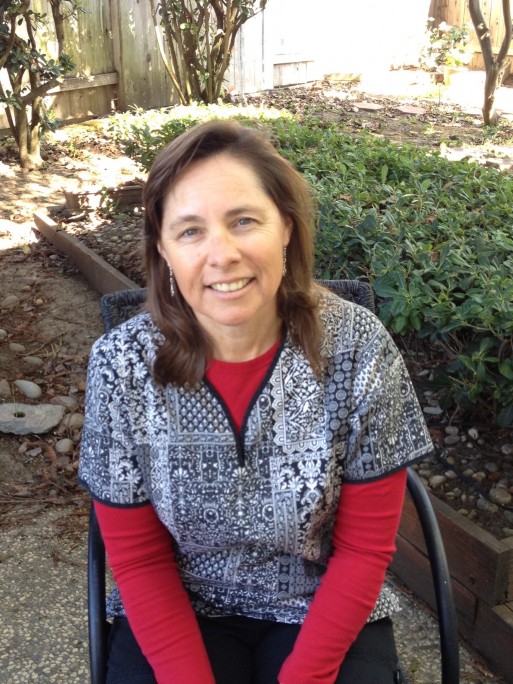Marilyn Reiss-Carradero, RN, BSN, CCRN, works at Santa Clara County Valley Medical Center in San Jose, CA, and advocates for change in palliative care and end-of-life practice. Here, she reflects on the day-to-day experiences in the hospital, the lack of preparedness in most patients for end-of-life, and the ways the system– and society– can be changed for the better.
 Liz: First, can you tell us a bit about what you do?
Liz: First, can you tell us a bit about what you do?
Marilyn: I have several different hats—at the moment, my role is Resource Nurse. There’s two of us in the hospital. We respond to rapid response calls, which is when the nurse at the bedside feels like their patient is getting sicker than she can handle and she needs help quickly. Or a code blue, when somebody has stopped breathing and their heart is stopped, we have a whole team that rushes to the scene. We handle emergencies throughout the whole hospital. Very often, there are situations where someone is in the process of dying, but decisions have not been made yet regarding how much treatment that patient is going to get: is it time to let the patient die? Has the family made that decision? Or are we going to aggressively treat the patient and escalate care to ICU? I’ve been in this role about two years, and prior to that I was in ICU—I worked for about 15 years in surgical and trauma ICU.
I’m also on the palliative care committee at our hospital. This committee meets once a month. I don’t have an official role, other than being a member, but over the last couple years I’ve chosen to educate myself in several different ways so I can get better at end-of-life care. Once I started to educate myself, I realized there’s a whole lot of things we should be doing to help our patients with a dignified end.
“The family feels this life still needs to be saved, and is holding on for a cure, or for the patient to be around another few days or weeks or months, and is in denial that this patient is dying. We’re no longer prolonging life; we’re prolonging death.”
Liz: What changes would you like to see in the community regarding palliative care and end-of-life education?
Marilyn: I don’t very commonly see a patient coming in with an advance directive, who really knows that they don’t want aggressive care. I rarely see that. What I usually see is a patient that’s never thought about it, hasn’t talked to family about it, and is now incapacitated and cannot make decisions themselves. And the family feels this life still needs to be saved, and is holding on for a cure, or for the patient to be around another few days or weeks or months, and is in denial that this patient is dying. We’re no longer prolonging life; we’re prolonging death.
We’re dealing with families that don’t want to let patients die. Period. And we’re having to convince them that it’s time. That scenario plays out every single day in my hospital.
In terms of changes I’d like to see, one would be education out in the community, especially in immigrant, non-English-speaking populations. They need to have discussions about the type of death that they would want. Most people do not want to die connected to a machine in a hospital, but that’s where they eventually end up. But we could have an educational campaign, advance directives out in the community. It is out there in some very educated, affluent populations, but not for the majority.
 Liz: What about changes within the hospital?
Liz: What about changes within the hospital?
Marilyn: Nurses and physicians need to be much more realistic about outcomes. There are certain types of patients that we know right away—elderly nursing home populations for one—may get very sick with pneumonia and end up on a ventilator. Right off the bat, there should be a discussion with the family, and they should be very frank that this patient is dying. This could even be in the ER, before they put a ventilator on the patient.
A lot of times physicians and nurses don’t use that word. But you can come into an emergency situation and right off the bat, tell the family, your loved one is dying. Tell them we’re at a point where, if they want to go naturally, if you want to allow them a natural death, we will certainly respect that and make him or her comfortable.
But what ends up happening is a physician or nurse will say, they are very, very sick, and this is what you can do to save their life: do you want it or do you not? And it’s very different, saying it like that. Do you want us to put a tube down her throat and save her life? And of course the family says yes. It might be that the patient has pneumonia and she has two days to live; if we put her on a ventilator, we may save her life and she may have a couple weeks and will go back to the nursing home. But it’s not explained that she will end up dying within the next two months anyway. They leave much sicker than they were before.
Even when we do think we can save the patient’s life, it’s still not portrayed in a very realistic light. We still don’t use that “death” word. So what I would like to see changed is a much more realistic prognosis, sitting down with the family, and explaining what allowing a natural death means. Or explaining what CPR really does to a patient, explaining how much suffering somebody might go through being put on a ventilator in ICU. We don’t do a lot of that explaining before actually doing the CPR or using the ventilator. And when the family agrees to these actions, they don’t necessarily understand that if it came to that point, the patient’s probably not going to make it out of the hospital anyway.
Liz: And what changes would you like to see on a national scale, within the health care system as a whole?
Marilyn: There was legislation in the health care package after Obama came into the presidency that would have insurance pay for that conversation. You could make an appointment with your doctor to have a conversation about your health, your wishes for end-of-life, and it could be documented in advance directives. But what ended up happening was politicians labeled it as a “death panel” and decided it shouldn’t be included in the legislation. And that’s really too bad. I’m hoping politics will not play as much of a role the next time such legislation comes up.
Liz: As a nurse, what kind of special perspective do you have on end-of-life in the hospital?
Marilyn: Once you’re in the hospital, the nurse is going to become your best friend. Because we are so much more intimately involved in the hands-on care of the patient, we can see if the patient is suffering and how much. We see the daily tasks and daily struggles. We administer the medications: for example, a lot of our patients are diabetic and they need insulin injections up to 4 times a day. If you add up all the pokes a patient is getting, it’s a lot: up to 10-12 pokes in a day, if there’s any trouble finding a vein. The nurses are the ones doing all that.
So we see our patients, we see them at the end of their congestive heart failure, or their emphysema. We see them always short of breath, always uncomfortable, and yet the aggressive treatments continue because that’s what the family wants and that’s what the patient thinks they want. But really, the conversation hasn’t been had yet that this is the end.
Nurses are the eyes for the physician and the advocate for the patient to the family. We need a lot of education out in the community; honest, earlier discussions with physicians; and nurses verbalizing the suffering of the patient.
Liz: What can doctors and nurses do to make patients, and their families, more comfortable at the end-of-life?
Marilyn: Once that decision has been made—which, I must say, is a minority of the time—it will depend on the symptoms the patient has at the end. Many times the symptom that worries nurses and families alike is shortness of breath. The patient breathes really fast and can’t talk, and pain is an issue. Putting the patient on a titrating morphine drip is a very easy order. A lot of times, we nurses don’t give the patient enough of that medicine because of our own discomfort with giving them too much. Educating nurses on that is a huge part of symptom and pain management. We need to become experts in giving the adequate amount of medicine. That’s what we’re promising the family and the patient: we promise to make your loved one comfortable, and we need to hold up to our promise.
And then there’s comforting the family. Recognizing that the family needs privacy, trying to get a private room, and then transitioning the family from one unit to another. Often we have to transfer the patient and it’s hard for families to move to a different unit, a different part of the hospital, where they don’t know the staff anymore. We want to make sure the family is physically comfortable with water, tissues, a La-Z-Boy chair. And then making keepsakes available after the patient has died: offering ribbon for locks of their hair, making a handprint clay mold, following up with how to take care of yourself after a loved one dies.
All this can be overwhelming for nurses and we’re grateful for social workers and chaplains who can take over when that happens. But with cutbacks, we don’t have that much, so more and more is falling on nurses to take on that role.
 Liz: Finally, what words of wisdom can you leave our SevenPonds readers with regarding making such end-of-life decisions for themselves or a loved one?
Liz: Finally, what words of wisdom can you leave our SevenPonds readers with regarding making such end-of-life decisions for themselves or a loved one?
Marilyn: As a patient or a family member, I would always ask the physician and the nurse: If this were your mom, how would you make the decisions? Some are comfortable giving you an honest answer and some aren’t, but it’s very telling. We see this all the time, and we’ve definitely made up our minds on what we would do. A lot of it is minimal care. Get them out of the hospital. Accept it’s the end. If you can get into a hospice situation, do it.
And then secondly, advance directive forms. There is an advance directive form under the state of California that’s kind of wordy, but the important part is where it says, in so many words, if I’m in a vegetative state or incurable disease state, I no longer wish to be on life support. Do not resuscitate me. I would like to be made comfortable in my final hours.
That type of advance directive is what a lot of people are doing, but really the conversation needs to be that, at some point in your life you’re going to be ready for natural death. This is going to be true for the elderly population. Maybe they’ve already lost a spouse, or seen their children grow up, or are proud of their grandchildren, or have just had a good life. And if something happened to them, they can allow that death to happen.
For me as a mom right now, I’m 45 and I have two kids, so I’m not going to sign something like that. I want them to resuscitate. But if I get to that age and I’ve seen my kids grow and there’s nothing more left to lose, I’m ready to go. I would like to allow natural death. In America, talking about death like that is not very common. So I would really encourage your readers to think about death in that way—allowing natural death—because it gets very complicated when you walk into an ER and the doctor says, well, you’re very sick but if we incubate you we could save your life. Shop around for your advance directives, and talk to your family about it very frankly.
Liz: Thank you for speaking with us, Marilyn!

 An Interview with Marilyn Reiss-Carradero
An Interview with Marilyn Reiss-Carradero


 First the Wealth Gap, Now the U.S. Has a Growing Health Gap
First the Wealth Gap, Now the U.S. Has a Growing Health Gap

 Our Annual Seven Holiday Gifts for Someone Who Is Grieving, 2024 Edition
Our Annual Seven Holiday Gifts for Someone Who Is Grieving, 2024 Edition














